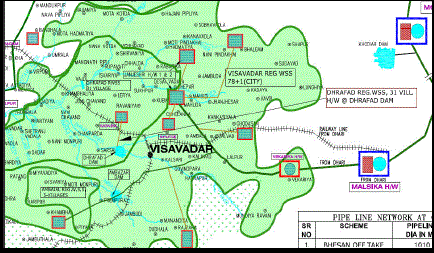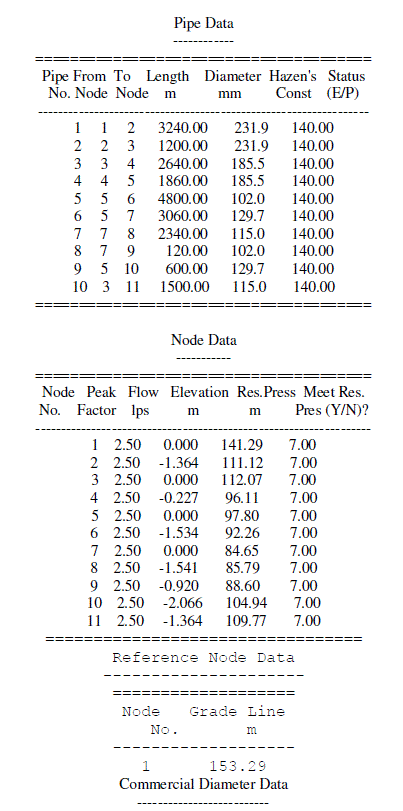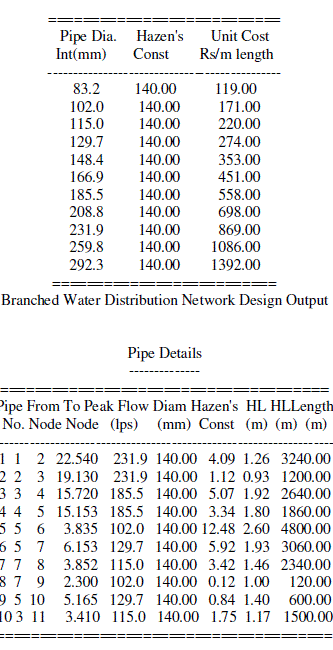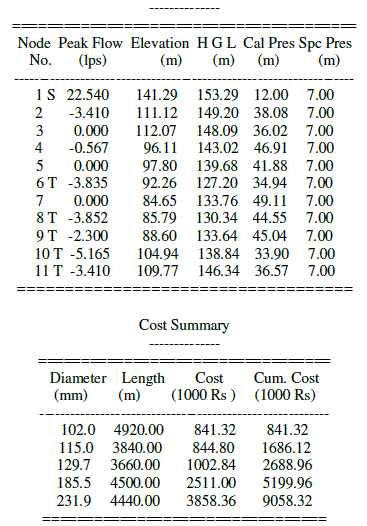ISSN ONLINE(2319-8753)PRINT(2347-6710)
ISSN ONLINE(2319-8753)PRINT(2347-6710)
Janki.H.Vyas 1, Narendra.J.Shrimali 2, Mukesh.A.Modi 3
|
| Related article at Pubmed, Scholar Google |
Visit for more related articles at International Journal of Innovative Research in Science, Engineering and Technology
Pipe network analysis determines the flow rates and pressure drops in the individual sections of the network. Classical approach for automatically solving the problems of network is by using specialized software such as Branch 3.0. The purpose of this study is to design the network of Dhrafad regional water supply scheme for better performance using Branch and to address any improvements required to existing infrastructure and/or the mode of operation, in order to improve quantity and quality of water distributed to the consumers.
Keywords |
| Water distribution; optimization; performance; water demand; pipe flow |
INTRODUCTION |
| With the increase in population, demand of water supply on the civic amenities including water supply for domestic purposes, irrigation, industry etc. has increased. Therefore, identification of sources of water supply, their conservation and optimal utilization is of utmost importance. Even the present scale of water supply to urban and rural population is grossly inadequate and not all communities are provided with safe drinking water. Pipe water system is one of the best systems to supply water safely, adequately and continuously. To supply adequate, safe and continuous water in rural areas, regional water supply schemes are formed in which more than one village are served from a common water source through pipe system. |
| Such schemes prove solutions to provide drinking water to regions facing groundwater scarcity and no perennial non-contaminated surface source of water. They have potential to operate at economy of scale, provide quality service and can also offer long term feasible solution in areas with acute water shortage. |
| In this work, Dhrafad regional water supply scheme of Visavadar taluka of Junagadh district of Gujarat state is selected as study area for the design of water supply network for 31 villages. As existing network is old, it results in frequent breakouts and low pressure problems. Hence, it is required to be optimized using Branch for its better performance. |
STUDY AREA |
| Dhrafad regional water supply scheme includes 31 villages of Visavadar taluka of having population of 56949. The source of Dhrafad regional water supply scheme is Dhrafad dam situated near village Sarsai on Dhrafad River at Visavadar taluka. |
| From Dhrafad dam i.e. surface source the raw water is pumped to the water treatment plant of capacity 7.50 MLD. The treated water is then distributed to the village G.L. Cisterns through service reservoirs G.L. sump or elevated water tanks. For proper use of water, the distribution gravity main system is divided into four zones 1, 2, 3, 4A & 4B. The ultimate distribution is through internal pipeline and stand post. The distribution system includes 2 elevated service reservoir, sump and pump house with machinery gravity main and rising main pipeline. |
 |
METHODOLOGY |
| A) About Branch 3.0 |
| Branch Version 3.0, herein referred to as BRANCH, could be used for the optimal design of new or partially existing, gravity branched water distribution system. It has been programmed to fully exploit the available memory of the computer in a dynamic manner. This style of programming thus gives an opportunity to the user design large networks without much compromise on the optimal solution. |
| A branched water distribution network can be considered to consist of supply nodes, demand nodes and pipes. Water in such a conceptual network is supplied to various nodes from the supply nodes. Design of a branched water distribution network involves selection of an appropriate pipe diameter (or every pipe, so the water can be transported without violating specified hydraulic constraints and maintain the desired minimum pressures at nodes. |
| Selection of an economical and yet feasible diameter forms an important step in the design of a branched water distribution network. Since there are no explicit guidelines or procedures to identify directly a unique set of feasible diameters to meet the specified objectives, the design of a branched water distribution network involves a trial-and-error procedure. For a large branched water distribution network consisting of several pipes, this procedure is indeed tedious and can lead to expensive solutions. |
| Branch 3.0 has several additional features that increase its user friendliness and productivity significantly. These includes |
| • Window based menus with highlight |
| • Hierarchical menus |
| • Context specific on-line help |
| • Improved and generalized file operations for copying, renaming and moving |
| • Sophisticated check data option for finding data entry and syntax errors |
| • Configuration option to allow the user to maintain data files in various subdirectories, declare name of organization, name of currency etc |
| • Automatic check for the equipment configuration and required OOS version |
| • Command line option to set up Branch for different run time memory models, printer paper specifications, help and output displays |
| • Facility of an on-line electronic abridged manual |
| • Supports to color monitor and Installation routine. |
| Program Version: BRANCH 3.0 |
| Language: Quick Basic 4.5 |
| Code: Structured optimized |
| Memory handling: Dynamic |
| Operating system requirements: DOS, MS-Windows (95, 98, 2000) |
| Menu driven system: Hierarchical and structured, Window based with highlighted bar, Online context specific |
| Design: Linear programming formulation for gravity main network |
| Calculation method: Hazen-Williams, Darcy-Weisbach |
| Data Input: Tabular oriented input |
| Data Output: Tabular output in format of .doc files |
| Calculation capacity: 125 no. of pipes, 126 no. of nodes, maximum commercial diameter input up to 20 no. |
| Language: English |
| Handbook: English, electronic manual |
| a) Input data |
| After loading the new file various data’s such as Node positions of the network, pipe positions between nodes of the network, reduced levels for nodes, hydraulic grade level, length of pipes, coefficient of pipe material used, populations of villages and commercial diameter assumed to be used from schedule of rates are input. Different sheets for node details, pipe details, commercial diameter, hydraulic grade level and general detail exists in Branch. |
| The values for peak factor, minimum residual pressure, minimum and maximum headloss are assumed as per standard criteria. |
| The supply through pipe network is calculated using Hazen-william equation for no. of population served. After inputting data the iteration process is carried out this calculates cost of pipe network, most economical pipe diameter, pressure, unit headloss and peak flow with help of Hazen-William or Darcy-Weisbach equation. The data’s are also checked for hydraulic run analysis. |
| b) Analysis and results |
| After check data the results are generated which are saved as output file. The detail for one zone which serves 8 villages of Dhrafad is shown below. |
| Echoing Input Variables |
| Title of the Project : DHRAFAD |
| Name of the User : PVC |
| Number of Pipes : 10 |
| Number of Nodes : 11 |
| Number of Commercial Diameters : 11 |
| Peak Design Factor : 2.5 |
| Minimum Headloss in m/km : .001 |
| Maximum Headloss in m/km : 3 |
| Minimum Residual Pressure m : 7 |
| Type of Formula : Hazen's |
 |
 |
 |
| Similarly, for other zones design is carried out. The calculated minimum and maximum pressure is observed to be 12.00 m and 50.67 m respectively and the minimum and maximum unit head loss is observed to be 0.57 m/km and 2.92 m/km respectively. The total cost of system for 31 villages is observed to be 559 lakhs. |
CONCLUSION |
| The design done using Branch gives optimized result. Proposed optimized system is designed in such a way that almost majority of the pipe network can be created using PVC 6 kg/cm2 pipes which will enhance hydraulic conditions of the flow due to less resistance of PVC, light in weight and also its easily available and economical diameter. |
References |
|